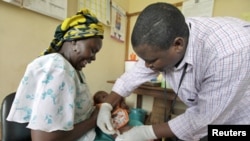Progress against Malaria is one area where U.S. investments in global health have made an incredible impact. Just five years ago, it was estimated that malaria killed nearly one million children annually in sub-Saharan Africa. The economic cost to the continent was estimated to be nearly $30 billion each year in lost productivity.
"Today, the U.S. along with its partners have helped cut malaria cases in half in more than 40 countries and reduced childhood malarial deaths by 200,000, and even seen a reduction in all-cause child mortality in seven initial Presidential Malaria Initiative countries," said USAID Administrator Raj Shah. He added, "I find that statistic astounding."
The President’s Malaria Initiative, which is led by the U.S. Agency for International Development and implemented jointly with the Centers for Disease Control and Prevention, has led the fight against this preventable and curable disease which is currently the leading cause of death among children in Africa.
"Today, we have a lot to celebrate, because the rates of death resulting from malaria infection are decreasing," said Rear Admiral Tim Ziemer, the U.S. Global Malaria Coordinator. "However, we need to be sobered by the job ahead of us."
That's because despite lower infection and death rates, and despite the fact that the disease is both preventable and treatable, it is estimated that a child in Africa still dies every 45 seconds from malaria.
The President's Malaria Initiative, now a central part of the Global Health Initiative, was introduced in 2005 to concentrate on fighting the disease. Its goal is to reduce malaria-related deaths by 50 percent in 15 focus countries by the year 2016.
["We] believe we can push the Initiative’s success even further," said USAID Administrator Raj Shah. "Over the next five years, . . . .we can save an additional 500,000 lives a year, most of them young children."
To do so, the U.S will work with partners to train health care workers to quickly identify whether a fever is caused by malaria; develop more effective insecticides that kill the mosquitoes without harming people; and we must find cheaper, more efficient ways to produce artemisinin.
"Finally," said Dr. Shah, "we need to seek the ultimate answer to malaria: a cheap, effective vaccine. Through the Malaria Vaccine Initiative, USAID will support the development and testing of promising candidates."
Advancing Against Malaria

Progress against Malaria is one area where U.S. investments in global health have made an incredible impact.
















